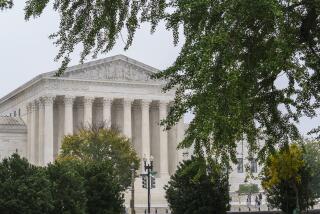Good guys, bad guys -- and Miranda
- Share via
During oral argument before the U.S. Supreme Court in late March in the case of J.D.B. vs. North Carolina, Justice Stephen G. Breyer posed the following question with no small degree of sarcasm: “And what is the terrible thing, the awful thing that has to happen if the officer isn’t sure whether this individual thinks he’s in custody or not? Suppose the officer just isn’t sure. What terrible thing happens?” He then answered his own question: “The terrible thing that happens is you have to give them a Miranda warning.”
Minutes later, Justice Antonin Scalia offered his own response when he said: “We don’t want Miranda warnings to be given where they are unnecessary because they are only necessary to prevent coercion, and where there’s no coercion, we want confessions, don’t we?” To emphasize his point, he added, “It’s a good thing to have the bad guys confess that they’re bad guys, right?”
J.D.B. vs. North Carolina is merely the latest Supreme Court case to address the question of when and under what circumstances police must advise suspects that they can refuse to answer questions and consult with a lawyer. Implicit in Breyer’s remarks is the recognition that this so-called warning has a negligible effect on most interrogations. Explicit in Scalia’s retort is a resistance to giving criminal suspects any perceived advantage during an investigation. Generally, neither side probes much deeper than that, but they should.
The case involved a 13-year-old boy, J.D.B., who was questioned by police at his middle school about local break-ins. According to prosecutors, the juvenile court judge and the North Carolina appellate courts, the boy had no right to be told that he could remain silent and have a lawyer because he was not “in custody”; only custodial interrogation triggers the duty to give the warning, as established by Miranda vs. Arizona in 1966. The question before the Supreme Court now is whether his youth should be considered when determining whether a “reasonable person” would have felt free to leave, the applicable test for whether questioning was custodial.
One of the underlying ironies of this case is that social science research shows that most youths and many adults do not understand the language or significance of Miranda warnings. Studies also suggest that even when suspects do understand the warnings, they are not deterred from confessing. In addition, empirical data have demonstrated that Miranda warnings fail to counteract the pressures inherent in a custodial interrogation. Because police officers continue to use coercive techniques and practices when questioning suspects, Miranda warnings are ineffectual in lowering the risk of false confessions.
Two days after the Supreme Court argument in this case, the New York Times reported that the FBI instructs its agents to interrogate terrorism suspects about immediate threats to public safety without giving them Miranda warnings. An FBI memorandum dated October 2010 encourages agents to interpret public safety questions broadly, justifying a “significantly more extensive” interrogation without Miranda warnings than would be permitted in an “ordinary criminal case.”
The question of whether terrorism suspects should be told they have the right to remain silent and can have a lawyer has become a flashpoint for politicians. Conservatives contend that any obligation to read suspects their Miranda rights burdens the police and impedes criminal investigations, while liberals defend the use of Miranda without acknowledging its limitations or proposing alternatives.
We as a society must begin a more honest dialogue regarding how best to protect suspects’ constitutional rights while not hampering the reasonable investigative techniques of law enforcement. We all benefit when criminal charges are brought against the person who actually committed the crime instead of merely making a quick arrest to appease the public and close the case.
As Breyer asserted, there is little harm in giving Miranda warnings when it is unclear whether a suspect feels free to leave, as often occurs during the questioning of youth, as in J.D.B. vs. North Carolina.
However, if we are to engage meaningfully with this issue, more is required. A simplified version of the warning for young suspects and consultation with a trusted adult is an apt place to start, which some police departments have begun to explore. Another option is mandating the video recording of police interviews with suspects, which several states have done. In fact, in jurisdictions where video recording has been implemented, law enforcement has consistently reported that it has had no negative effects on the investigative process. A third proposal would place time limits on police questioning to prevent repeated or protracted and potentially coercive sessions. A further improvement would be to ban the use of lying, trickery and false promises of assistance or leniency by law enforcement during interrogation.
Although none of these proposals is a panacea, if we want to elicit accurate, reliable information from criminal suspects, and if we want to stanch the flow of false confessions, we must get beyond our single-minded focus on the Miranda warning.
More to Read
Get the L.A. Times Politics newsletter
Deeply reported insights into legislation, politics and policy from Sacramento, Washington and beyond. In your inbox twice per week.
You may occasionally receive promotional content from the Los Angeles Times.









